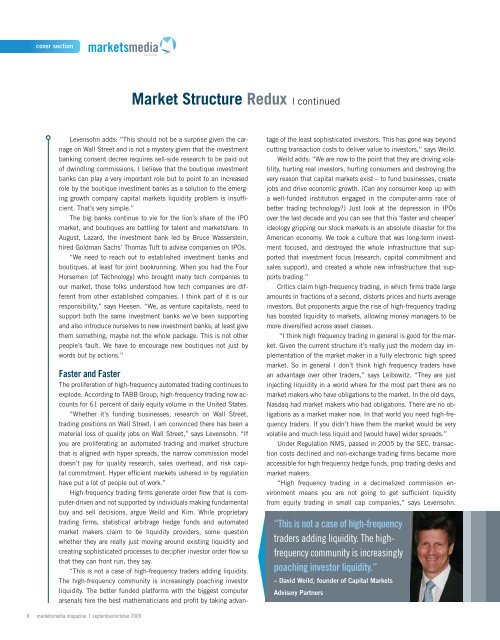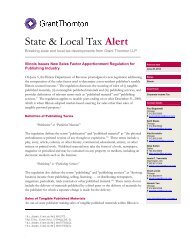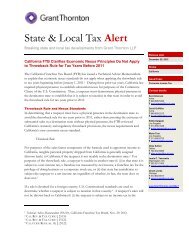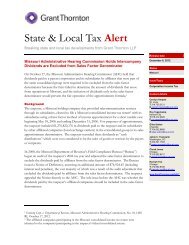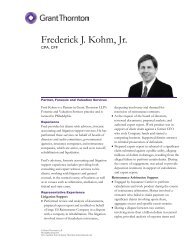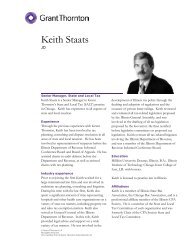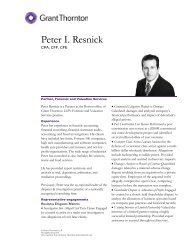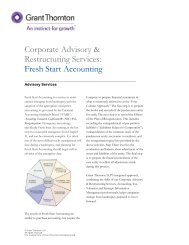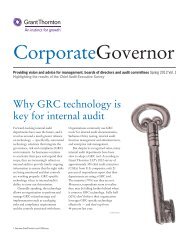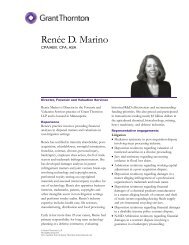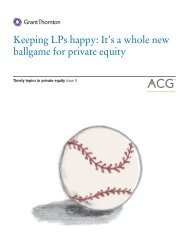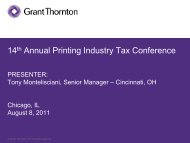Market Structure Redux - Grant Thornton LLP
Market Structure Redux - Grant Thornton LLP
Market Structure Redux - Grant Thornton LLP
You also want an ePaper? Increase the reach of your titles
YUMPU automatically turns print PDFs into web optimized ePapers that Google loves.
cover section<br />
<strong>Market</strong> <strong>Structure</strong> <strong>Redux</strong> I continued<br />
Levensohn adds: “This should not be a surprise given the carnage<br />
on Wall Street and is not a mystery given that the investment<br />
banking consent decree requires sell-side research to be paid out<br />
of dwindling commissions. I believe that the boutique investment<br />
banks can play a very important role but to point to an increased<br />
role by the boutique investment banks as a solution to the emerging<br />
growth company capital markets liquidity problem is insufficient.<br />
That’s very simple.”<br />
The big banks continue to vie for the lion’s share of the IPO<br />
market, and boutiques are battling for talent and marketshare. In<br />
August, Lazard, the investment bank led by Bruce Wasserstein,<br />
hired Goldman Sachs’ Thomas Tuft to advise companies on IPOs.<br />
“We need to reach out to established investment banks and<br />
boutiques, at least for joint bookrunning. When you had the Four<br />
Horsemen (of Technology) who brought many tech companies to<br />
our market, those folks understood how tech companies are different<br />
from other established companies. I think part of it is our<br />
responsibility,” says Heesen. “We, as venture capitalists, need to<br />
support both the same investment banks we’ve been supporting<br />
and also introduce ourselves to new investment banks; at least give<br />
them something, maybe not the whole package. This is not other<br />
people’s fault. We have to encourage new boutiques not just by<br />
words but by actions.”<br />
Faster and Faster<br />
The proliferation of high-frequency automated trading continues to<br />
explode. According to TABB Group, high-frequency trading now accounts<br />
for 61 percent of daily equity volume in the United States.<br />
“Whether it’s funding businesses, research on Wall Street,<br />
trading positions on Wall Street, I am convinced there has been a<br />
material loss of quality jobs on Wall Street,” says Levensohn. “If<br />
you are proliferating an automated trading and market structure<br />
that is aligned with hyper spreads, the narrow commission model<br />
doesn’t pay for quality research, sales overhead, and risk capital<br />
commitment. Hyper efficient markets ushered in by regulation<br />
have put a lot of people out of work.”<br />
High-frequency trading firms generate order flow that is computer-driven<br />
and not supported by individuals making fundamental<br />
buy and sell decisions, argue Weild and Kim. While proprietary<br />
trading firms, statistical arbitrage hedge funds and automated<br />
market makers claim to be liquidity providers, some question<br />
whether they are really just moving around existing liquidity and<br />
creating sophisticated processes to decipher investor order flow so<br />
that they can front run, they say.<br />
“This is not a case of high-frequency traders adding liquidity.<br />
The high-frequency community is increasingly poaching investor<br />
liquidity. The better funded platforms with the biggest computer<br />
arsenals hire the best mathematicians and profit by taking advantage<br />
of the least sophisticated investors. This has gone way beyond<br />
cutting transaction costs to deliver value to investors,” says Weild.<br />
Weild adds: “We are now to the point that they are driving volatility,<br />
hurting real investors, hurting consumers and destroying the<br />
very reason that capital markets exist – to fund businesses, create<br />
jobs and drive economic growth. (Can any consumer keep up with<br />
a well-funded institution engaged in the computer-arms race of<br />
better trading technology?) Just look at the depression in IPOs<br />
over the last decade and you can see that this ‘faster and cheaper’<br />
ideology gripping our stock markets is an absolute disaster for the<br />
American economy. We took a culture that was long-term investment<br />
focused, and destroyed the whole infrastructure that supported<br />
that investment focus (research, capital commitment and<br />
sales support), and created a whole new infrastructure that supports<br />
trading.”<br />
Critics claim high-frequency trading, in which firms trade large<br />
amounts in fractions of a second, distorts prices and hurts average<br />
investors. But proponents argue the rise of high-frequency trading<br />
has boosted liquidity to markets, allowing money managers to be<br />
more diversified across asset classes.<br />
“I think high frequency trading in general is good for the market.<br />
Given the current structure it’s really just the modern day implementation<br />
of the market maker in a fully electronic high speed<br />
market. So in general I don’t think high frequency traders have<br />
an advantage over other traders,” says Leibowitz. “They are just<br />
injecting liquidity in a world where for the most part there are no<br />
market makers who have obligations to the market. In the old days,<br />
Nasdaq had market makers who had obligations. There are no obligations<br />
as a market maker now. In that world you need high-frequency<br />
traders. If you didn’t have them the market would be very<br />
volatile and much less liquid and [would have] wider spreads.”<br />
Under Regulation NMS, passed in 2005 by the SEC, transaction<br />
costs declined and non-exchange trading firms became more<br />
accessible for high frequency hedge funds, prop trading desks and<br />
market makers.<br />
“High frequency trading in a decimalized commission environment<br />
means you are not going to get sufficient liquidity<br />
from equity trading in small cap companies,” says Levensohn.<br />
“This is not a case of high-frequency<br />
traders adding liquidity. The highfrequency<br />
community is increasingly<br />
poaching investor liquidity.”<br />
– David Weild, founder of Capital <strong>Market</strong>s<br />
Advisory Partners<br />
8<br />
marketsmedia magazine I september/october 2009


